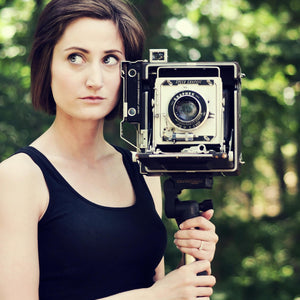- Lightroom Presets
- Mobile Presets
-
Photoshop
-
Learn
-
Support
-
Install
- Best Sellers
- Blog
By Anna Gay on | No Comments

Are you looking to achieve that creamy, background blur and shallow depth of field in your image that you were not quite able to achieve in camera? It is definitely possible to do this in Photoshop and I am going to show you how.
Adding blur to your image during post-processing can create the illusion of a shallower depth of field than what occurred in camera. As with any photography technique, this effect can be used subtly or dramatically, depending on your style.
There are several different blur filters in Photoshop, and in this tutorial we will be looking at the Lens Blur Filter.

For this type of selection work, I prefer to use the Magnetic Lasso Tool in order to create a selection with irregular edges. We do not want the line between the blurred and sharp portions of the image to be extremely obvious, so avoiding harsh lines is key:

In this image, there is already a fairly shallow depth of field, so I can easily see where I want to enhance the blur.
For now, I am using the Magnetic Lasso and selecting only the sharpest portions of my image - so, I am selecting my subject and her immediate surroundings, and everything that is in sharp focus, mainly in the middle of the image:

In order to keep my line between blur and sharp as minimal as possible, I am going to feather the edges of my selection by right clicking, and then selecting Feather>100 pixels:

Next, I want to select the inverse of my current selection: right click>Select Inverse:

Before adding the blur, make sure you have duplicated your Background layer.
Then, select Filter>Blur>Lens Blur in your top tool bar. The Lens Blur dialogue will appear:

Play around with different values of blur to see how the sliders affect the image. Below are the settings that I have used for this image. As you can see, the blur is very intense, but I will show you how to tone it down in the following steps:

Next, add a Layer Mask to the Background Copy layer:

By using a Layer Mask and selecting a soft, black brush, I can now erase portions of blur in my image. For example, around my subject's head:

You may also find it helpful to use varying opacities on your brush when blending in the blurred portions of your image. Starting with a low opacity and building up the brush strokes will help you achieve a more blended line between blurred and sharp:

Here is the before (top) and after (bottom) of the effect we just created:

For a similar effect, you can also use the Faux Tilt Shift action that's included in the Pretty Photoshop Actions PURE Color Worfkflow Portrait Action Collection. This action is so easy to use, I highly recommend it!
Do you have any questions or comments about Blurring a Background in Photoshop Using Photoshop's Lens Blur? Leave us a comment below - We would LOVE to hear from you! And PLEASE SHARE this post using the social sharing buttons (we really appreciate it)!




Anna Gay is a portrait photographer based in Athens, GA and the author of the dPS ebook The Art of Self-Portraiture. She also designs actions and textures for Photoshop. When she is not shooting or writing, she enjoys spending time with her husband, and their two cats, Elphie and Fat Cat.

Comments